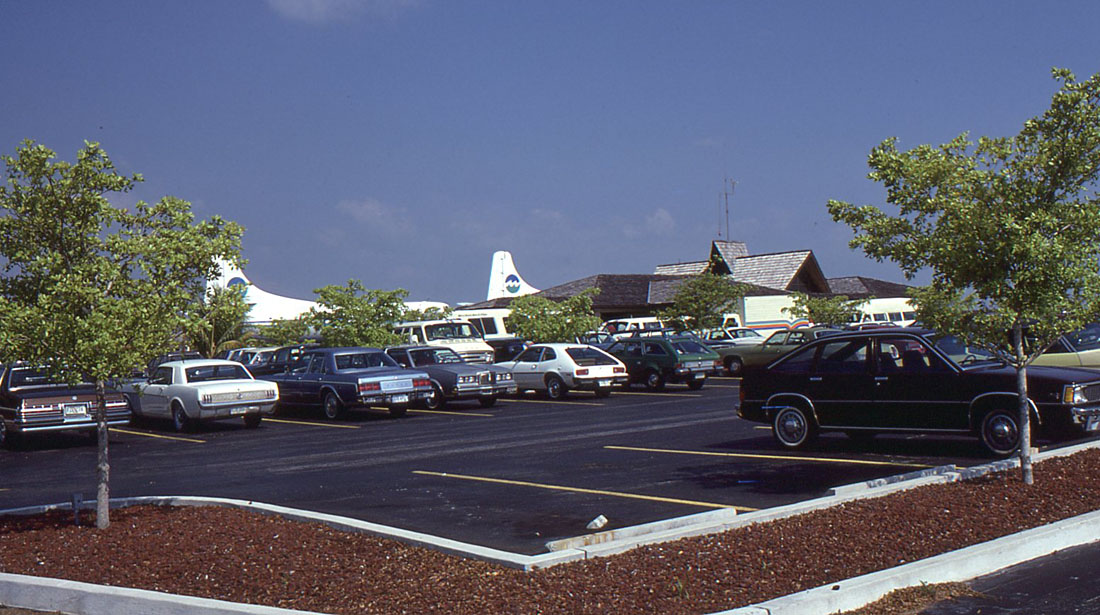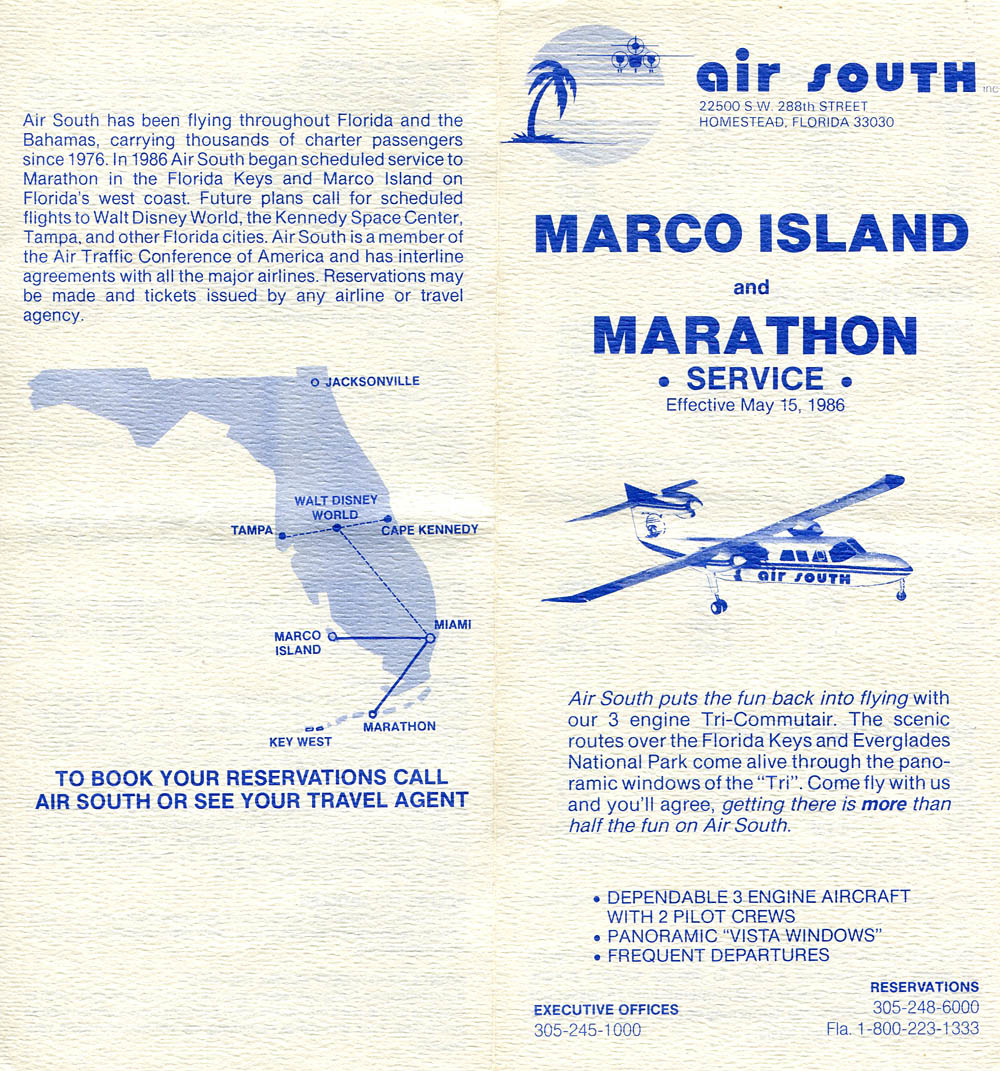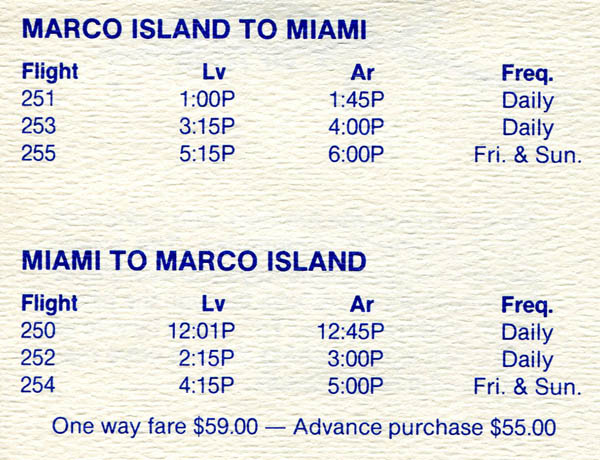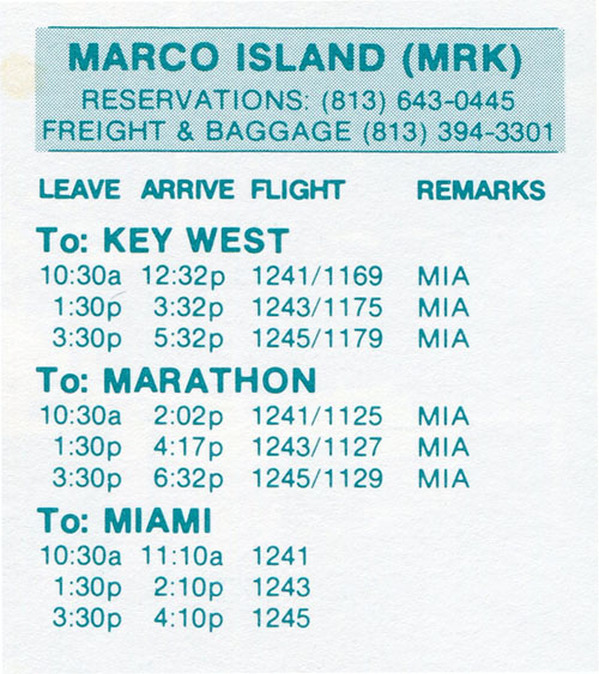MARCO ISLAND AIRPORT IN THE 1980s
This is the third part of our look back at airline service at Marco Island, Florida.
Part One / Part Two
Part One / Part Two
Commercial aviation was thriving at Marco Island during the 1970s. Thanks to the islands principal developer, the Deltona Corporation, Marco Island gained its own flagship airline Marco Island Airways in 1972 and a brand new $3 million airport in 1976. The decade ended on a high note for both the airline and airport with years of steady growth and consecutive record passenger boardings. With the dawning of the 1980s, however, things began to go wrong and a number of factors led to a rapid decline for Marco Island's hometown airline. The passage of airline deregulation in 1978 allowed airlines to choose their own routes without government approval. As a result, nearby Ft. Myers saw a huge increase in direct jet flights from major airlines, lessening the need for connecting commuter flights between Marco Island and Miami. The U.S. was also facing a recession at the time, causing a significant drop in leisure travel. Meanwhile, Marco Island Airways parent company, the Deltona Corporation, was facing enormous losses related to an onslaught of lawsuits from government agencies and environmental groups concerning the effects of real estate development on nearby wetlands and coastal areas. These factors, along with the inherently volatile nature of the Florida commuter airline market, led to a steep decline in passenger boardings and financial stability. From 1979 to 1982, enplanements dropped by more than 50%.
The above photo shows Martin 404s lined up on the ramp at Marco Island in 1980. In addition to the established Marco - Miami route, Marco Island Airways inaugurated service to Tampa in 1980 with two daily round-trips. Below: Another 1980 view of Marco Island Airport near its peak of commercial airline service, with a nearly full parking lot and a pair of Martin 404s readying for the next flights.
The above photo shows Martin 404s lined up on the ramp at Marco Island in 1980. In addition to the established Marco - Miami route, Marco Island Airways inaugurated service to Tampa in 1980 with two daily round-trips. Below: Another 1980 view of Marco Island Airport near its peak of commercial airline service, with a nearly full parking lot and a pair of Martin 404s readying for the next flights.
Marco Island Airways flight schedule effective February 1, 1981 showing recently added service to Tampa and an advertisement for Marriott's Marco Beach Hotel and Villas resort.
An advertising mailer from February 1981 promoting new flights between Marco Island and Tampa.
Marco Island Airways, shortened to Marco Airways, purchased a trio of 9-seat Piper Navajos in 1981 and they were regularly used at Marco Island, primarily on flights to Tampa.
Marco Airways began operating flights as an Air Florida Commuter carrier on June 15, 1982, maintaining 2 to 3 daily Marco-Miami round-trips with the Martin 404s. This is the Air Florida route map effective April 15, 1983.
The Deltona Corporation continued to suffer enormous losses following a 1982 settlement agreement which barred them from developing the majority of their land holdings due to environmental issues. As a result of the settlement, Deltona gave the deed to Marco Island Airport to the state. With losses mounting, Marco Airways was sold to Provincetown-Boston Airline (the largest commuter airline in the U.S. at the time) on October 5, 1984. PBA also received an exclusive lease on the airport. This image is from the cover of the Winter 1984-85 PBA Flyer newsletter, courtesy of Gordon Werner.
Within weeks of taking over Marco Airways and the airport lease, PBA was grounded by the FAA on November 10, 1984 for safety violations, leaving Marco Island without air service for several weeks.
When PBA returned to the skies on November 25th, 1984, they were initially limited to flying 9-passenger Cessna 402s. As a result, Marco Airways fleet of 1950s-vintage Martin 404s were grounded and never returned to service.
Using the small and economical Cessnas, PBA increased flight frequencies between Marco and Miami to 7 round-trips (6 on Saturdays), up from Marco Airways previous 2 daily flights.
When PBA returned to the skies on November 25th, 1984, they were initially limited to flying 9-passenger Cessna 402s. As a result, Marco Airways fleet of 1950s-vintage Martin 404s were grounded and never returned to service.
Using the small and economical Cessnas, PBA increased flight frequencies between Marco and Miami to 7 round-trips (6 on Saturdays), up from Marco Airways previous 2 daily flights.
An 1985 aerial view of the Marco Island Airport ramp shows a PBA Cessna 402 at the terminal. At the bottom of the photo, the fuselages and remains of two partially scrapped Marco Island Airways Martin 404s are visible.
Passenger boardings continued to plummet and PBA left Marco Island in November 1985 as a cost-cutting measure after filing for protection from creditors under Chapter 11 of the U.S. Bankruptcy Code. Homestead-based Air South took over the Miami route in May 1986 but, with virtually no advertising or name recognition, planes were often empty and flight cancellations were frequent. After seven unsuccessful months, Air South abandoned Marco Island in December 1986, leaving the city without airline service for the third time in a little over 2 years.
PBA returned in February 1987, offering three daily Miami round-trips using Cessna 402s. This return was short-lived, though. Suffering continued financial losses, PBA announced its departure from all but one of its Florida routes and left Marco Island for the final time on April 30, 1987.
To my knowledge, there was no regular scheduled airline service at Marco Island after the departure of PBA in 1987 until early 2016, when Raven Air Island Hoppers briefly operated flights to Key West. Unfortunately, that lasted only a few months before they discontinued service due to complications with FAA regulations. While companies such as Raven Air now offer charter flights with small aircraft, the days of large passenger airliners carrying thousands of tourists a week during the winter months are now a distant memory. These days, the airport is named Marco Island Executive and the ramp is full of corporate and private jets. With today's interstates and the emergence of nearby Ft. Myers airport as one of the top 50 in the United States, there really isn't a need for connecting flights to Miami and Tampa anymore. Considering recent trends at other smaller airports in Florida, Marco Island might someday see limited jet service to the northeast by a niche carrier such as Elite Airways. As larger airports become more congested, that would certainly seem feasible.
Hope you enjoyed this look back at the history of airline service at Marco Island. If you have any stories or old photos of Marco Island Airport that you would like to share, please CONTACT ME ! I'd love to hear from you.
Hope you enjoyed this look back at the history of airline service at Marco Island. If you have any stories or old photos of Marco Island Airport that you would like to share, please CONTACT ME ! I'd love to hear from you.















